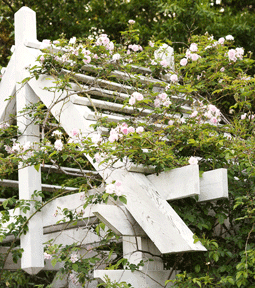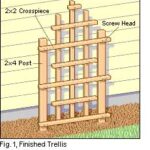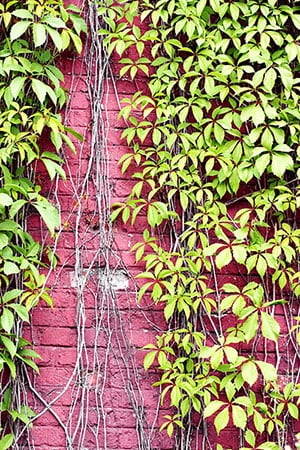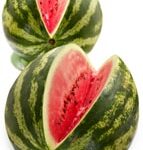This expert buying guide will help you choose the right vines for your trellises. Learn about the different types of vines available, and how to choose the right vines for your climate.
For many homeowners, an overhead or gazebo is not just a way to provide shade or shelter but also a means to enhance the garden. Climbing vines are an integral consideration in many designs, providing color, lush foliage, fragrance, and shade seasonally or year-round, depending on where you live.
If such is your desire, your plan could include a watering system that will meet the needs of your plantings yet not deliver water directly to a wood structure. Even so, all posts and beams should be well treated with a wood preservative to prevent moisture damage.
Following is a list of some of the hardiest vines, by their common names and scientific names (if different) and the minimum temperatures that the plants will endure in winter.
Anemone clematis (C. montana; 10 degrees F.)
This deciduous, fast-growing vine showcases white to pink flowers in early spring before its leaves emerge. A vigorous climber, its light-green leaves provide moderate to dense shade. It requires light pruning.
Blood-red trumpet vine (Distictis buccinatoria; 24 degrees F.
A rapidly growing evergreen vine, this plant blooms when the weather is warm; its trumpet-shaped flowers are orange red fading to bluish red. It provides moderate shade.
Bougainvillea (30 degrees F.)
Though the peak flowering period comes in summer, blooms—in dazzlingly bright colors of purple, magenta, crimson, brick red, orange, yellow, pink, or white—may appear from spring through autumn and even into winter in the mildest climates. A fast, vigorous grower with medium-green leaves, this evergreen supplies moderate to dense shade.
Clematis jackmanii (20 degrees F.)
Though it provides only very light shade, this vine is prized for its large purple flowers, which emerge in summer. Dormant stems must be cut back when new growth starts in the spring.
Common white jasmine (Jasminum officinale; 5 degrees F.)
This rapidly growing evergreen vine loses some of its foliage in colder regions. Fragrant white flowers bloom throughout the spring. After blooming, the vine must be thinned and pruned to maintain its attractiveness.
Evergreen clematis (Clematis armandii; 0 degrees F.)
A slow starter, evergreen clematis grows rapidly in warm weather and provides light to moderate shade. It has glossy dark-green foliage that droops downward, creating a strongly textured pattern; flowers, which appear in spring, are fragrant, white, and shaped like stars. After blooming, the plant must be pruned to keep it in check.
Giant Burmese honeysuckle (Lonicera hildebrandiana; 20 degrees F.)
The dark-green leaves of this plant provide moderate shade. Fragrant flowers up to 7 inches long bloom in summer. They are white when they first open and then turn yellow and soft orange as they age.
Grapes (American, 25 degrees F.; European, 10 degrees F.)
The luxuriant foliage of this deciduous and rapidly growing vine produces dense, cool shade. Fruiting varieties yield edible grapes but may also attract insects.
Roses (0 degrees F.)
Vining roses provide light to moderate amounts of shade and usually grow rapidly. Many varieties are available; choose disease-resistant types with foliage that does not easily mildew.
Sweet autumn clematis (Clematis dioscoreifolia robusta, 10 degrees F.)
From late summer into autumn, this deciduous vine offers frothy masses of small, fragrant creamy-white flowers and glossy dark-green leaves. It grows quickly and provides moderate to heavy shade.
Wisteria (30 degrees F.)
(Pictured above) Fragrant, pendulous clusters of white, pink, lavender, or purple flowers characterize this popular vine. The light-green foliage provides moderate to heavy shade.
NEXT SEE: Types of Vines








 Don Vandervort writes or edits every article at HomeTips. Don has:
Don Vandervort writes or edits every article at HomeTips. Don has:



